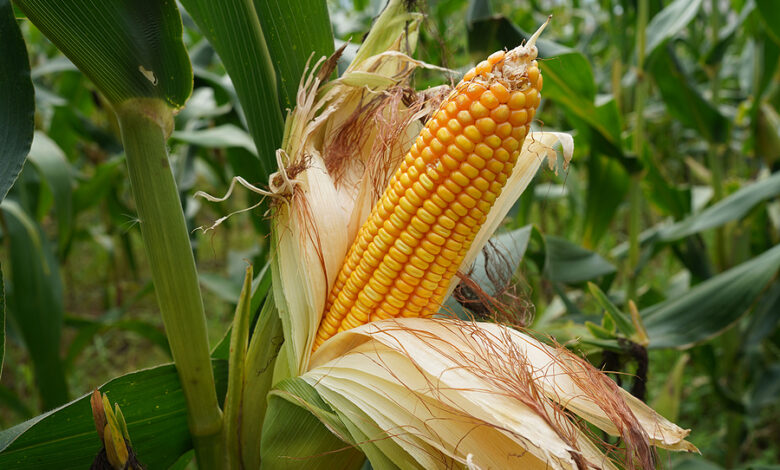Yard and Garden: Planting Sweet Corn FAQs
Proper planning allows sweet corn to be enjoyed all summer long

Sweet corn fresh from the garden makes a tasty addition to a summer picnic, but gardeners need to plant sweet corn soon to enjoy this tasty treat throughout the summer. In this article, horticulturists with Iowa State University Extension and Outreach offer tips for selecting the best cultivars and planting sweet corn.
What are the differences between the various types of sweet corn?
There are five main types of sweet corn available to home gardeners. These types vary in sugar content, texture, length of harvest period, storage life, seed vigor and germination requirements. The five main types of sweet corn are standard sugary (su), sugary enhanced (se), supersweets (sh2), synergistic (syn) and augmented supersweets (shA or aug). Within each of these major types are cultivars that will ripen in the early, mid and late seasons.
Standard sugary (su) cultivars have been grown for many years. These cultivars have the traditional sweet corn flavor and texture, but don’t store well and are only of the best quality within the first day after harvest, because sugars quickly convert to starch after harvest.
Sugary enhanced (se) cultivars contain the sugary enhanced gene that produces ears with sweet, tender kernels. Compared to su cultivars, sugar levels of se types are higher and the storage life is 1 to 2 days longer.
Supersweet (sh2) cultivars contain the shrunken-2 gene. These cultivars have very high sugar levels, and convert sugar to starch slowly, allowing for a longer harvest period and a storage life for up to one week with refrigeration. The seedcoats on kernels are rather thick, giving the corn a firmer, crunchy texture.
Synergistic (syn) sweet corn cultivars possess su, se and sh2 genes. Synergistic cultivars are sweet, creamy and tender. Augmented supersweets (shA or aug) are an improved type of supersweet cultivars as they also contain the se gene; therefore, they are also sweet and tender. Both syn and shA cultivars have an excellent storage life.
When should I plant sweet corn?
Many gardeners want to plant sweet corn as early as possible to get an early summer harvest. However, when planted too early in the season, soil temperatures can be too low to promote good, consistent germination, increasing the risk of seed rot in cold, wet soil. Most seeds are treated to help prevent rot and will be dyed pink to indicate that they’ve been treated.
Some types of sweet corn more readily germinate and grow in colder soil temperatures and can be planted earlier than others. Standard sweet corn (su) cultivars can be planted in late April in central Iowa (a little earlier in southern Iowa and a little later in northern Iowa). It is recommended that sugar enhanced (se) and synergistic (syn) cultivars be planted one week later than standard sweet corn cultivars. In general, supersweet (sh2) and augmented supersweets (shA/aug) cultivars are the least tolerant of cold soil temperatures. As a result, these cultivars should be planted later than other types (mid-May in central Iowa).
For a continuous supply of sweet corn, plant early, mid-season and late cultivars. Alternatively, the same cultivar can be planted in blocks every two weeks. The last practical planting date for early cultivars is July 1.
What is the correct way to plant sweet corn in the home garden?
Plant only fresh seeds, as planting old seeds will likely result in poor germination and irregular plant stands. Sweet corn performs best in full sun and fertile, well-drained soils with a pH between 6.0 and 6.5. Sow seed at a depth of 1 inch in heavy soils. In light sandy soils, the planting depth can be 2 inches. Space seeds 8 to 12 inches apart in rows 2½ to 3 feet apart. Sweet corn may also be planted in “hills.” Sow 4 to 5 seeds per hill with approximately 3 inches between seeds. Hills should be spaced 2½ feet apart with 2½ to 3 feet between rows.
Sweet corn requires high levels of nitrogen and moderate amounts of phosphorus and potassium to grow well. Prior to planting, incorporate 2 to 3 pounds of fertilizer per 100 square feet by spreading an all-purpose fertilizer, such as 10-10-10, uniformly over the area and incorporating it into the top 3-4 inches of soil.
How much sweet corn should I plant?
Plants typically produce one good ear of corn per stalk and at least one secondary ear that is usually smaller and lower in quality. When good management practices are applied, such as adequate fertilization and applying approximately 1 inch of water (either from rainfall or irrigation) per week and controlling weeds, the expected yield should be 11 to 13 ears per 10-foot row.
Can sweet corn be planted near popcorn or field corn in the garden?
Sweet corn should be isolated from popcorn and field corn to prevent cross-pollination, since the quality of sweet corn will be lowered if it’s cross-pollinated by other types of corn. For example, sweet corn pollinated by popcorn will be tough and starchy.
Different types of sweet corn should also be isolated from each other to prevent cross-pollination, which can lower the quality of the sweet corn. In particular, supersweet and augmented supersweet cultivars should be isolated from standard, sugary enhanced and synergistic sweet corn types. Additionally, isolate sugary enhanced cultivars from standard and synergistic cultivars.
Furthermore, cross pollination from different colors of sweet corn can decrease color purity in the kernels. White kernel cultivars will develop yellow kernels if pollinated by yellow or bi-color corn, and pollen from yellow corn will lead to extra yellow kernels in bi-color cultivars. Pollen from white corn will not affect yellow or bi-color cultivars.
Isolation can be achieved by planting different types at least 250 feet apart; however, this is not a practical option for most home gardeners due to limited space. Another option is to stagger planting dates or select cultivars that mature at different times. A minimum of 14 days should separate the tasseling time of different corn types.




